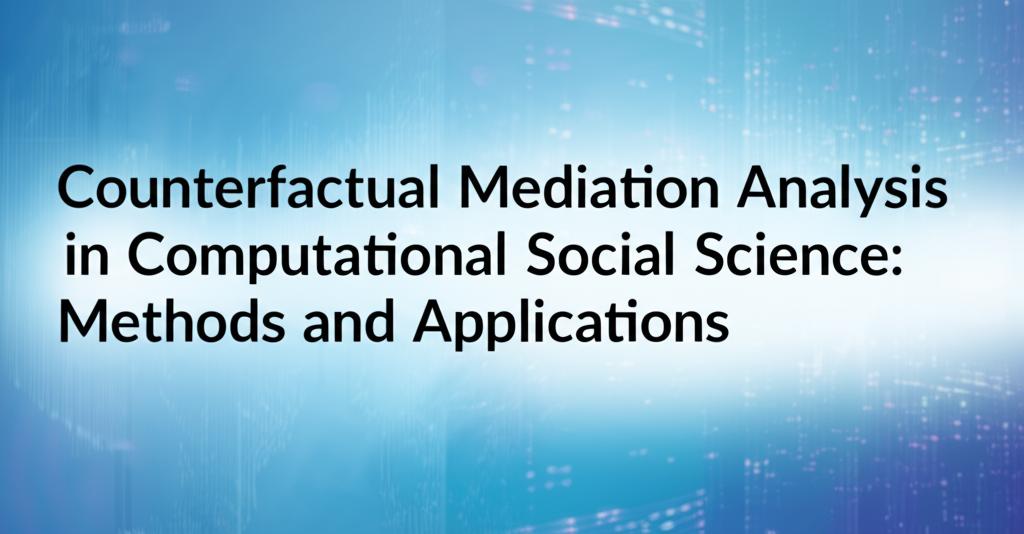Counterfactual mediation analysis is a powerful framework for understanding causal mechanisms in computational social science. It moves beyond traditional mediation approaches by leveraging the concept of potential outcomes to define and estimate direct and indirect effects. This allows researchers to investigate how and why an exposure or intervention leads to an outcome through one or more mediating variables, even in complex scenarios with interactions and non-linearities.
At its core, counterfactual mediation analysis asks "what if" questions. For example, what would the outcome have been if a participant had been exposed to an intervention, but their mediator value was what it would have been without the intervention? By comparing such potential outcomes, researchers can disentangle the direct effect of the exposure on the outcome from the indirect effect that operates through the mediator. Key estimands in this framework include the Natural Direct Effect (NDE), Natural Indirect Effect (NIE), and the Controlled Direct Effect (CDE).
Methodological Advancements:The field is continually evolving, with several key methodological trends emerging:
- Addressing Limitations of Classical Approaches: Traditional methods, often based on Structural Equation Modeling (SEM) like the Baron & Kenny method, have limitations. They can struggle with non-continuous variables, often overlook confounding variables, and may not adequately handle the structural relationships among multiple mediators, potentially leading to biased estimates. The counterfactual framework, often utilizing Directed Acyclic Graphs (DAGs) and the Potential Outcomes framework, addresses many of these shortcomings. Its advantages include independence from linear assumptions, the ability to capture interaction effects, and the use of DAGs to clarify causal pathways, leading to more precise effect estimates.
- Handling Complex Data: Researchers are developing and refining methods to apply counterfactual mediation analysis to more complex data structures. This includes scenarios with latent class exposures or mediators (unobserved subgroups within a population), multiple mediators, and even situations where data comes from different sources or has missing information. Techniques are being developed to integrate various datasets, even those with only summary-level information, to perform mediation analysis.
- Incorporating Machine Learning: AI-driven algorithms and machine learning techniques are increasingly being integrated into mediation analysis. These methods can handle high-dimensional datasets, automatically detect complex mediation pathways that might be missed by traditional approaches, and model non-linear relationships and interactions more flexibly. This includes automated variable selection to identify potential mediators in large datasets without pre-existing hypotheses.
- Advanced Statistical Techniques: Beyond traditional linear models, advanced statistical techniques are enhancing the accuracy of mediation effect estimation. Bootstrapping methods are used to improve confidence interval estimation for indirect effects, especially with smaller samples or non-normally distributed data. Bayesian mediation analysis offers more flexible modeling by incorporating prior information. Structural Equation Modeling (SEM) provides a comprehensive framework for handling multiple mediators and latent variables.
- Software and Implementation: The development of sophisticated software tools and packages (e.g., in R and Mplus) is making these advanced methods more accessible to applied researchers. These tools simplify the estimation of mediation and moderation effects and facilitate the use of complex models.
- Sensitivity Analysis: There's a growing emphasis on the importance of sensitivity analysis to assess how robust the findings are to potential unmeasured confounding or violations of model assumptions. This is crucial for ensuring the reliability of research conclusions.
Counterfactual mediation analysis has broad applicability across diverse areas of computational social science:
- Understanding Online Behavior: Analyzing how interventions or features on social media platforms influence user behavior (e.g., engagement, information sharing) and through what psychological or social mechanisms these effects occur.
- Policy Evaluation: Assessing the impact of social policies and identifying the pathways through which they bring about change. For example, understanding how an educational intervention improves student outcomes by examining mediators like increased engagement or improved teacher practices.
- Health and Well-being: Investigating the mechanisms behind health interventions or the social determinants of health. For instance, examining how a public health campaign reduces risky behaviors by mediating changes in attitudes or perceived norms. Sensitivity analysis using real-world data, such as the National Survey on Drug Use and Health, can underscore the practical significance of these effects.
- Addressing Bias and Fairness: Using causal mediation approaches to detect and mitigate biases in algorithmic systems and large language models. For example, identifying how gender or racial biases in data might be mediated through specific model components to produce unfair outcomes in sentiment analysis or other AI applications.
- Neuroscience and Economics: Decomposing causal pathways in brain-behavior relationships or deciphering mechanisms behind economic behaviors like consumer decision-making.
- Testing Complex Social Theories: Providing a more rigorous framework for testing multifaceted social science theories that involve direct and indirect causal pathways, moving beyond the limitations of traditional linear structural equation modeling.
The ongoing integration of counterfactual reasoning with advanced computational methods and diverse data sources promises to further deepen our understanding of complex causal processes shaping social phenomena. As datasets grow in size and complexity, the evolution of mediation methods will likely continue, incorporating more techniques from data science and high-performance computing, leading to real-time and dynamic mediation analysis.

